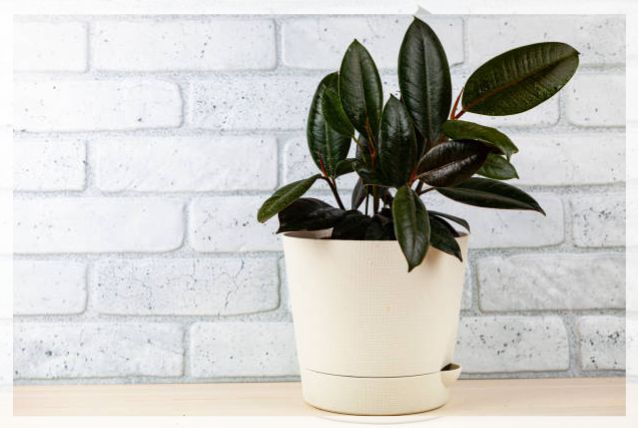Do you know that Ficus Elastica or Rubber tree is a famous ornamental plant from the Ficus genus?
In its natural habitat, it tends to grow about 30 meters tall.
However, the varieties that you grow indoors are more manageable in height.
Moreover, if you are an indoor grower looking for a tree-type plant species with stunning and attractive foliage, you can grow ficus elastics.
It can grow from 1 foot to over 8 feet tall, thus making it an excellent choice.
There are a number of varieties of ficus elastics that you can grow indoors successfully.
The most common one is Ficus elastica decor which has shiny leather-like leaves and can grow a foot long.
While ficus robusta has large leaves than decora.
Furthermore, F. Elastica black prince or burgundy has black reddish leaves and you can select from a number of variegated types.
Keep on reading.
Ficus Elastica
Ficus elastic also known as rubber plant is an unusual-looking variety that is native to the tropics of Southeast Asia.
This long-lived plant tends to boast oversized, oval-shaped leaves with a rich emerald hue.
And it tends to grow quickly that reach up to 100 feet tall in its natural habitat.
Moreover, it is not the easiest plant to grow as beginners as it is not very forgiving if it does not get the care it needs.
However, in most cases, you will be growing it indoors as a houseplant where you can plant it and care for it year-round and you can keep its size to a manageable length.

When it comes to caring for the rubber tree, care is pretty straightforward.
It will need adequate light, moisture, and warmth like other tropical plants.
Give it a southern or eastern exposure however, keep it a number of feet away from the windows.
And you will be rewarded with an exotic addition to your indoor plant collections.
Learn more about Ficus Plant Care and Growth here.
Quick facts about Ficus Elastica
Some quick facts about ficus elastica are:
| Botanical Name | Ficus elastica |
| Common Name | Rubber plant, rubber tree |
| Plant Type | Evergreen tree |
| Mature Size | 50–100 ft. tall (outdoors), 50–100 ft. wide (outdoors) |
| Sun Exposure | Partial shade |
| Soil Type | Moist but well-drained |
| Soil pH | Acidic |
| Bloom Time | Rarely blooms |
| Flower Color | Rarely blooms |
| Hardiness Zone | 10–12 (USDA) |
| Native Area | Asia |
| Toxicity | Toxic to dogs and cats |
Learn more about Poisonous Plants for Pets here.
Looks and Display of Rubber Plant
When you are growing this plant indoors, it is all about having a small tree indoors with broad shiny attractive leaves
When this plant is about 1 to 2 feet tall, you can place it as a centerpiece on a table, on a shelf, or on a windowsill.
However, once it begins to grow above 3 feet it will look great when you place it near a fireplace, television area, or near door entrances, as long as there are no cold drafts.
Once the plant begins to mature and grow in height, you can train your plant and support its trunk and branches by staking.
Or you can tie them back to keep them growing upright.
Moreover, it is important to note that you can grow these plants easily when you take care of their needs.
However, one mistake you may make is over-watering the plant, moving the plant too much, or to a spot where it receives less light or with colder temperatures.
A sudden drop in temperature or cold drafts is not good for this plant.
Growing Ficus Elastica Indoors
While rubber plants are hardy varietal, they can be challenging to care for and will need specific care requirements to thrive.
They will need the right balance in their environment will a lot of light, and moisture, but not soggy soil, and enough fertilizer to keep it healthy.
Moreover, indoors it can grow to about 10 feet tall, though outside, it can grow up to 100 feet tall in its natural habitat.
The most common varieties of growing indoors are:
- Ficus elastica ‘Tineke’,
- Ficus elastica ‘Burgundy’,
- Ficus elastica ‘Ruby’,
- Ficus elastica ‘Robusta’.
Moreover, these all varieties tend to grow well indoors when you provide them with the right conditions, like enough sunlight, but not bright, direct sunlight.
This is because it can easily scorch its leaves.
Growing Ficus Elastica Indoors
FIcus Elastic has waxy-looking leaves that start with a pink coral hue, that eventually deepens to dark rich green.
As the plant grows, it will begin to droop, so you will need to support the plant and its leaves by using a long wooden dowel or a bamboo stalk.
This will help the plant to keep upright.
Sunlight: Like most plants in the genus, ficus elastic loves to thrive in lots of bright diffused light.
Moreover, they can tolerate soft morning sunlight, however, you should not move them out of the line of harsh direct rats in the afternoon.
This is because they can singe the leaves of your plant.
Make sure that your plant does not receive sufficient light as it can become leggy, and lose its lower leaves, and the leaf color can become dull instead of glossy and vibrant.
Water: Make sure to water your plant frequently, as they like to be kept steadily moist but not soaked in water.
The Ficus elastica plant is vulnerable to excessive dryness and will not tolerate drought well.

To check if it is time for another watering, check the moisture levels in the first few inches of the soil.
However, if they are dry and crumbly, it is time to water your plant.
Temperature and Humidity: Like other ficus plants, these plants are also vulnerable to cold drafts.
Unhealthy plants can become leggy, with stretching internodes and the leaves may also turn yellow.
They can then turn brown before dropping off completely.
In most cases, you can keep ficus Elastica in moderate to warm temperatures between 60 degrees Fahrenheit and 75 degrees Fahrenheit.
Moreover, make sure that the humidity you provide them is moderate for the plant.
However, if your home tends to be dry, you can invest in a space humidifier to increase the levels.
Fertilizer: Feed your plant with a weak liquid fertilizer throughout the growing season.
It is important to note that rubber tree is relatively a heavy feeder when healthy.
Some experts recommend that you only need to lightly fertilize indoor plants to prevent stretching and plants becoming root-bound as they tend to grow too fast.
Potting Soil and Drainage for Indoor Plants
When it comes to the soil composition for the ficus elastic planting indoors, these are not picky plants.
In most cases, any good, fast-draining potting soil is best for them, while many indoor gardeners opt for a cactus mix.

Additionally, rubber plants tend to prefer an acidic soil mixture.
Like fiddle leaf fig trees, which ficus elastic resembles, they also “eat” their soil and will gradually have their roots exposed.
When this happens, simply top your pot with additional soil and it will not be an issue.
Propagation Tips and Techniques
You can propagate ficus elastic from leaf-tip cuttings, however, it is not as straightforward and is probably easier to just buy a new plant.
If you are taking cuttings, you will need to use a rooting hormone and be very vigilant about high humidity and plenty of warmth.
Moreover, do not be discouraged if you are unable to propagate this plant easily.
It is an inexact science that will take some time.
To propagate your plant, follow the steps below:
- you will need a piece of the stem often from a growing tip which needs to be 4 to 6 inches long
- make sure to remove all the leaves, however, if the sap is oozing, wait until it stops, and then wash it off gently
- then plant the stem with the remaining leaf in compost or perlite
- you can dip the cut bottom end into the rooting hormone, but it is not important
- the growing media needs to be moist
- place the pot in a warm spot with indirect sunlight
you can get the best results in bottom heat or doing propagation during summer.
Repotting Ficus Elastica
Ficus elastic tends to grow quickly under the right conditions and you will need to repot it every year until the plant reaches the height you want.

It is important to note that larger plants can be difficult to repot.
So if you are unable to move the container, you can scrape off a few inches of the potting media.
Then replace it with new potting soil.
Common Pests, Diseases, and Problems
Ficus elastic is vulnerable to a number of pests that often infest indoor houseplants.
These include:
- aphids
- mealy bugs
- spider mites
- scale insects
- thrips
If you are able to identify the infestation as early as possible, treat it with the least invasive option like neem oil.
Some potential problems of this plant are:
Loss of Leaves: The most common cause is overwatering, which will need attention immediately.
You will need to renew the topsoil or repot the plant.
While other conditions that can cause the leaves to drop are:
- low temperatures
- not enough light
- cold drafts
In such cases, move your plant from a bright location to a dim spot.
It is also normal for some of the bottom leaves to turn yellow and drop, however, do check if the conditions are fine.
Leaf Edges Turn Yellow: This can be the process of elimination.
The problem can be poor soil, underfeeding, or too much water.
You will need to check each one of the care instructions and eliminate what you are not doing well and try to find the cause.






Leave a Reply